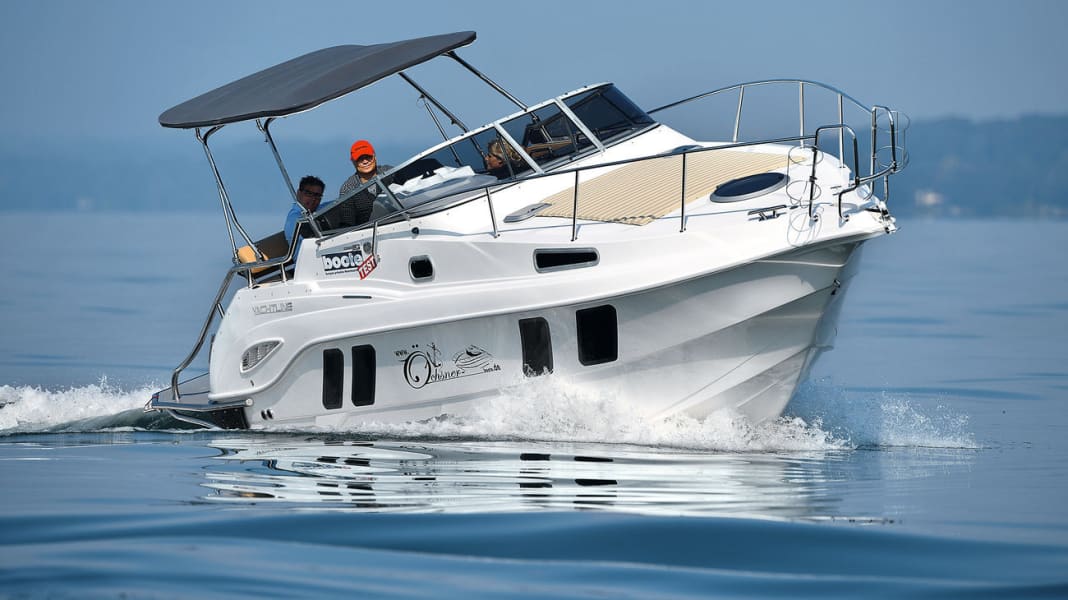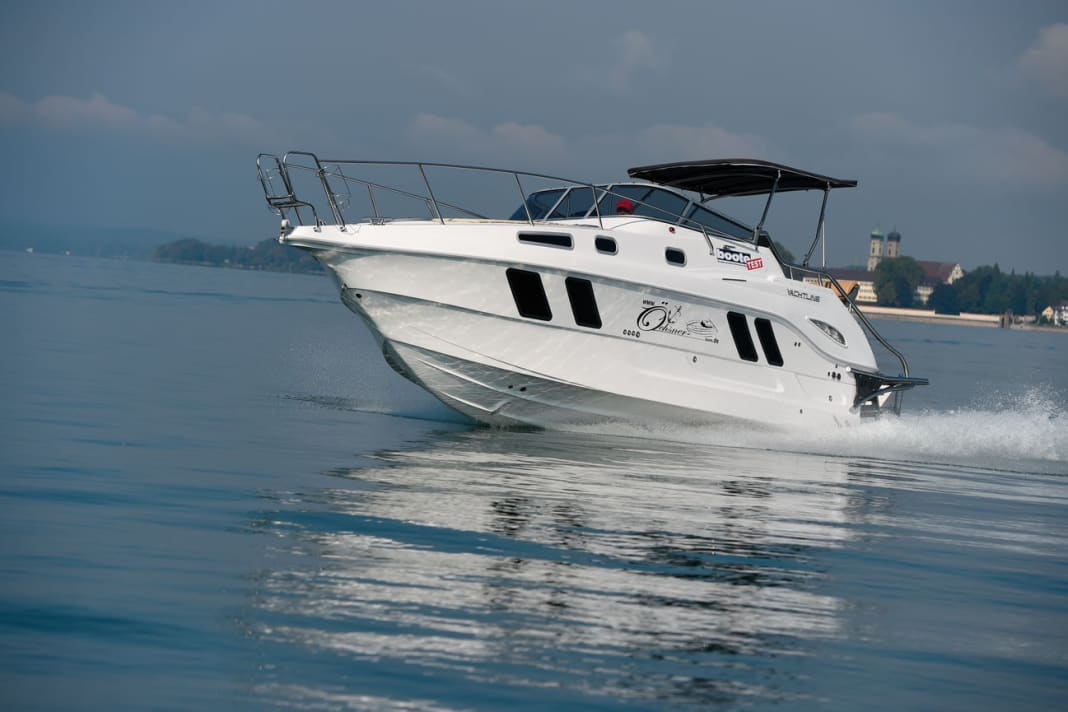
This test appeared in BOOTE issue 12/16. You can read the latest tests in the printed magazine or in the digital edition.
If you still simply want to run your boat on a normally brakedTrailer If you want to transport a boat, there is no getting around the technical data of 3.5 tonnes permissible total weight (trailer including boat) and a width of 2.55 m (a special permit is required above this).
The crux of the matter is that with increasingBoat length the weight increases and the lateral stability decreases while the width remains the same.






Designer Dieter Öchsner solves the latter problem in his SR30 Yachtline with the so-calledWide-beam hullin which the lower hull section is wider than in a conventional V-hull. The disadvantage of this design is that the boat has to be made from two hull halves, which is of course more complex and therefore more expensive.
The weight problem - it is, after all, a30-foot boat - The shipyard gets to grips with the GRP honeycomb structure. Honeycombs are incorporated between the outer and inner shells, which give the construction stability while hardly increasing the weight.
The information in the brochure and the actual weight often differ considerably.
We have a copy of our test boatWeighing protocol on which a weight of 3440 kg including trailer is noted. The "First Edition" equipment package, a second refrigerator, anchor, chains and two electric winches as well as around 50 litres of petrol were also weighed.
If the customer is still suspicious, Öchsner promises to drive to the public scales together at the handover date to determine the actual weight. However, the road captain should realise one thing: The water and faeces tanks must be empty, and there must not be too much equipment, food or clothing on board either.
Driving and manoeuvring
There is a choice of both diesel and petrol inboard engines from Volvo Penta. We are travelling with the most powerful version, a V6-280-CE-G (catalytic converter model) with duoprop drive. This takes the boat quickly from displacement to planing speed (1900 rpm to 3200 rpm).
Foresight is maintained reasonably well and you don't need to worry about the power trim, as the Volvo has a trim assistant that automatically sets the optimum trim angle. The trim tabs are only needed when leaning.
With the automatic transmission, we achieve a top speed of almost 35 knots and a calculated range of 114 nm plus 15% reserve. The Yachtline glides economically between around 20 and 24 knots; the V6 petrol engine then consumes 1.44 l/sm, resulting in a respectable range of almost 180 nm.
The fuselage handles fast bends with ease without hooking or rocking; in starboard turns, the Duoprop does tend to snap, but this can be quickly remedied by briefly easing off the throttle. There are also no unpleasant surprises on slalom courses or when the steering is twisted.
The same applies when crossing the steamer waves on Lake Constance, where the hull starts soft and dry at around 25 knots. On slow courses, the SR30 Yachtline yaws (the bow swings back and forth on its own); the best thing to do here is to let it swing and only compensate a little so that you don't steer too far to the other side again. In the harbour, tight turning circles are convincing and the bow thruster allows the nose to swivel quickly, which is particularly advantageous in windy conditions.
The steering, bow thruster and gearstick are easy to handle; this also applies to the "Glass Cockpit" from Volvo Penta. The touchscreen can be used to call up engine data as well as all navigation functions. A special treat: The unit can be connected to mobile devices.
Despite all the electronics, the shipyard has not forgotten the analogue compass, which shows the right way even in the event of a power failure.
The driver sits on a well-padded bench; the distance between this and the steering wheel is large enough for driving while standing. The untinted windscreen is made of Plexiglas. Disadvantage: a windscreen wiper would quickly scratch the material, which is why none was installed. However, anyone who has ever driven in the rain without windscreen wipers knows what it means to look through a windscreen covered in drops.
Engine, tank, electrics
The engine compartment can be accessed via a hatch (with two gas pressure dampers) in the cockpit, while two stainless steel bars facilitate access. Side ventilation openings with water tanks provide sufficient fresh air, and a 3-kg fire extinguishing system guarantees the necessary extinguishing success in the event of a fire.
The technician has enough space to work, and the separate fuel filter and stopcock for the fuelling system are on the to-do list. The electrical system and the entire installations make an equally good impression. With a few exceptions, this also applies to the workmanship. However, details such as the thick handrail/bar, which still has a few dents and rough spots, show that this is the first boat of its kind.
Living and equipment
Sleeping is on double berths in the bow and in the underfloor cabin. The latter is particularly suitable for children; the seating area of the saloon bench can be used as an additional berth. However, they all lack effective mattress ventilation.
Opposite the saloon seating area, the designer has arranged the galley with sink, fridge, single-burner hob and cupboard with holders for ten place settings and a matching work surface. Everything is also available in the wet room next door. However, the standing height of 1.62 metres restricts freedom of movement, especially when showering. Although this is not as discreet, it can be done more comfortably at the stern shower on the bathing platform.
A special feature on the platform is the "Chill & Go" unit. Depending on the folding position, this step device is available either as a gangway, water seat or swim ladder. A normal bathing ladder is also available; it must be used if a dinghy is placed on the "Chill & Go" construction, which can be easily pulled up with a winch.
But beware: the dinghy with outboard motor is not included in the weight and must therefore be transported in the towing vehicle. Outdoor enjoyment takes place on the convertible seating area in the cockpit and on the foredeck (with sun cushion), which can be reached safely via the centre passageway.
Finally, a few words about the price: for the "First Edition" version, it is 133,229 euros (with 240 hp petrol engine); those who want to save more than 10,000 euros have the option of a special deal (the boat then serves as an advertising medium). The conditions attached to this can be explained at this year's Boat & Fun Berlin, for example, where the Öchsner SR30 Yachtline can be seen in the flesh.
Conclusion
The Öchsner SR30 Yachtline is suitable for skippers who like to take care of their own land transport. Its dimensions are suitable for families of four or couples who occasionally want to take friends with them.
friends. The designer has come up with many practical solutions for comfort on board the cruising boat, such as the "Chill & Go" facility.

